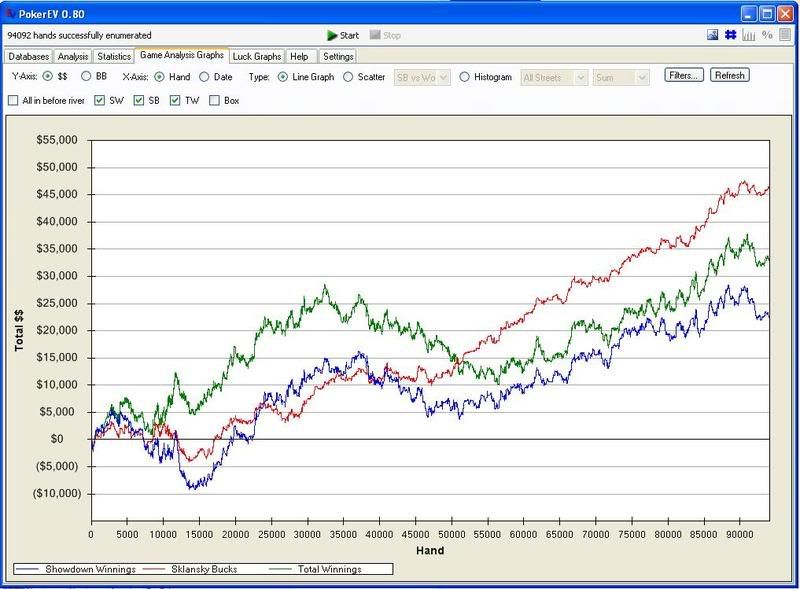After PokerEV came out, people started to realize just how much extra money some of the better players are winning without showdowns.
My computer is a POS so I'm not gonna ask it to make another one of these, but a while ago a student of mine asked to see a graph, so I just did my whole 3/6 database, before 2008 (because 2008 is a new database obv). Here it is:

Over that sample I'm winning just under 1 PTBB/100 IN NON-SHOWDOWN POTS. That may not sound like a lot but it is. For a few reasons. One reason being that most people are LOSING a few PTBB/100 in non-showdown pots, so in winrate its actually a difference of multiple PTBB/100, which is absolutely huge. Also I'm 9-tabling readless so those are basically just "vanilla" bluffs that I'm doing without reads.
Some people say I never make good strategy posts (anymore??) so hopefully in this thread I'll make a good one and illustrate some good spots to pick-up pots without a showdown.
My favorite spots to bluff:
You raise the button and the BB calls. The flop comes who the fuck cares and you get check-raised. Most people here just see if they have top pair or better, or a good draw, and muck if the answer is no. You do it. I do it. Your opponents do it.
So let's reverse it!
When the button opens and you're in the BB with KQo, instead of 3-betting and getting yourself in pots ONLY against hands you DON'T want to be playing against, call and check-raise a lot of flops. This works out great for a few reasons. By calling pre-flop they often put you on something like 77 or 67s. Now when the flop comes 267 you get a lot more credit. And they have a huge range with A9 and J8 and JT and all sorts of garbage that can't continue.
To be more specific, I really like flops that are draw heavy enough to allow you a lot of profitable turn cards with which you can double barrel, but not SO draw heavy that they will check behind with a lot of their random missed bullshit.
Here is a great example:
Note that if the 9 was a little lower, like, a 7, I would like this a lot less. That is because they are much less likely to bother c-betting with AT high. In that case they are more likely to have a big overpair or a set or something. Which they are obviously much less likely to fold than AT high.
In that hand I was planning on betting any 2, 6, 7, 8, 9 or diamond on the turn if he called my check-raise. Approximately.
Next spot I love:
Your opponent has a pretty narrow handrange. Your opponent has taken a line which indicates that he wants some money to go in the pot, but not a lot. He has indicated that he wants to control the pot size. His play indicates that he has a medium to slightly strong hand. Your hand range contains some weaker hands and some much much stronger hands.
Let's be more specific. Your opponent raises and you call. You check call a relatively dry board. They check behind on the turn. Then the river card falls. If your hand isn't strong enough to value-bet, you check and evaluate. You check and they make a 2/3rds pot bet. You look at your 88 and ponder whether he is bluffing, whether to call or to fold. I do it. You do it. Your opponents do it.
But what about raising? If they had two pair or a set, they almost certainly would have bet the turn.
This exact same line can apply to re-raised pots as well. Here is an example:
I would not recommend playing at that table. Lack of game selection FTL.
Gcnmoo is a good aggressive player. Why would he check behind on the flop with a flush draw? He wouldn't
Why would he check behind on the flop with a set? He wouldn't.
If he somehow did check behind with a set, why wouldn't he raise the turn after filling up? We are deepstacked and it would look bluffy. He needs to build the pot with a hand that strong, with these stacks. He doesn't appear to be doing so. He looks like he is intentionally trying to keep the pot small and manageable, so I do what any pain in the ass does, and do exactly what he doesn't want.
Much like the check-raising the flop from the BB concept (first hand I showed), you can apply the same principles/flop textures to raising flops in position, when you flatcall a cutoff raise on the button. Here is an example where I do that, and end up firing 3-barrels. Note the stack sizes.
People learn things about deep-stacked poker. They learn that only fish stack-off for 200 BB with one pair. When deepstacked I go out of my way to find spots where my opponent is quite unlikely to have greater than one pair, and I am quite capable of having better, and exploiting that by putting them to a decision for all their chips.
And my last example of a bluff I like,
You raise and your opponent calls in position. The flop texture is a pretty good texture to c-bet, so you bet. You are called and decide to give up and not second barrel. However your opponent checks behind. To me this screams pot control. Whenever people scream pot control, I usually try to make the pot get out of control.
I used to give up and check the river here, and it gets pretty old watching $230 pots slide to A7s here, so I decided to do something about it. Just pretend like you have kings and cram the river for "value."
The End.